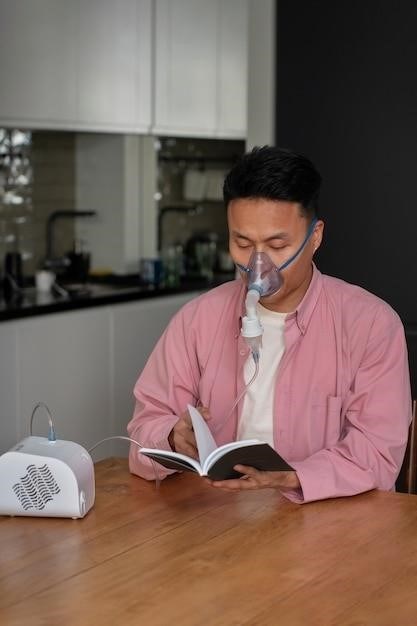ResMed AirSense 10⁚ A Comprehensive Guide
This guide provides a complete overview of the ResMed AirSense 10, encompassing setup, daily use, troubleshooting, and data management. Access downloadable PDFs of the user manual for various models, including AutoSet, Elite, and standard CPAP versions. Learn how to interpret your sleep data and share reports with your doctor. Explore advanced features like humidifier use and pressure adjustments for optimal therapy.
Getting Started with Your AirSense 10
Unboxing your ResMed AirSense 10 involves carefully removing all components⁚ the device itself, power cord, tubing, and your chosen mask. Familiarize yourself with each part and their placement. The user manual provides detailed diagrams and descriptions. Before initial use, ensure the device is properly plugged into a grounded outlet and the power is switched on. The device will perform a self-test; consult the manual if any error messages appear. Next, connect the tubing to both the machine and your mask, ensuring a secure fit. Refer to your mask’s specific instructions for proper placement and adjustment. Finally, adjust the ramp settings as instructed in the manual to start your therapy gradually. Remember, if you encounter any difficulties, refer to the troubleshooting section within the user manual or contact customer support for assistance. Proper setup ensures effective and comfortable CPAP therapy.
Understanding the Different AirSense 10 Models
The ResMed AirSense 10 family offers several models to cater to individual needs. The AirSense 10 CPAP provides consistent air pressure throughout the night, suitable for users with a stable prescription. The AirSense 10 AutoSet model automatically adjusts air pressure based on your breathing patterns, offering personalized therapy. This is ideal for users whose sleep apnea severity fluctuates. The AirSense 10 Elite builds upon the AutoSet features, adding advanced data tracking and a more sophisticated user interface. Each model’s user manual details its specific features and settings. Understanding these differences is crucial in selecting the most appropriate device. Consider consulting with your physician or sleep specialist to determine which AirSense 10 model best aligns with your diagnosis and therapy requirements. Choosing the right model ensures optimal treatment effectiveness and comfort throughout your sleep therapy journey.
Setting Up Your Device and Mask
Setting up your ResMed AirSense 10 involves several straightforward steps. Begin by carefully unpacking all components, including the device, power supply, tubing, and mask. Ensure the device is placed on a stable, level surface near your bed. Connect the power supply and tubing securely. Choose a mask that provides a comfortable and effective seal. Refer to your mask’s individual user guide for detailed fitting instructions. The AirSense 10’s user manual offers guidance on adjusting the humidifier (if applicable) and setting initial pressure parameters. Always consult your physician or sleep specialist for personalized pressure settings. Once everything is connected and adjusted, perform a brief operational check to ensure proper airflow. If you encounter any difficulties during setup, refer to the troubleshooting section of the user manual or contact ResMed support. A proper setup ensures optimal therapy delivery and enhances your overall sleep experience.
Daily Use and Maintenance
Daily use of your ResMed AirSense 10 begins by ensuring the device is properly connected and the mask fits comfortably. Before each use, inspect the tubing and mask for any damage or blockages. After each use, disconnect the tubing and carefully clean your mask according to the manufacturer’s instructions. Regular cleaning prevents the buildup of bacteria and ensures hygienic use. The frequency of cleaning varies depending on the mask type; always consult the mask’s individual user guide for specific cleaning instructions. For the AirSense 10 device itself, wipe it down gently with a damp cloth. Avoid using harsh chemicals or abrasive cleaners. Regularly check the humidifier chamber (if applicable) and clean or replace it as needed, following the instructions in your user manual. Proper daily maintenance prolongs the lifespan of your equipment and ensures consistent, effective therapy. Addressing any issues promptly, as detailed in the troubleshooting section of your manual, will contribute to uninterrupted treatment.
Troubleshooting Common Issues
Should you encounter problems with your ResMed AirSense 10, consult the troubleshooting section of your user manual. Common issues include leaks, which may be caused by a poorly fitting mask or damaged tubing. Check for proper mask fit and seal, and inspect the tubing for any kinks or blockages. If the device displays error messages, refer to the manual’s error code list for explanations and solutions. Low humidity might require adjustments to the humidifier settings, or a cleaning of the humidifier chamber. If the device isn’t powering on, check the power connection and ensure the power outlet is functioning correctly. Persistent problems despite troubleshooting efforts should prompt a contact with your healthcare provider or ResMed support. They can provide guidance or arrange for necessary repairs or replacements. Remember to always prioritize safe and effective use of your CPAP equipment; don’t hesitate to seek professional assistance when needed for optimal sleep therapy.

Data Management and Reporting
The ResMed AirSense 10 allows you to access, download, and share your sleep therapy data. View reports covering 30, 90, and 365-day periods via your myAir account. Share this valuable information with your doctor for optimal treatment.
Accessing and Downloading Your Sleep Data
Accessing your sleep data from the ResMed AirSense 10 is straightforward. The device utilizes an SD card to store your therapy data. To retrieve this information, you’ll need an SD card reader. Remove the SD card from your AirSense 10 device carefully and insert it into the SD card reader connected to your computer. Once the card is recognized by your computer, you can access the files containing your sleep data. These files are usually in a format that can be opened by the ResMed AirView software or other compatible data analysis programs. Alternatively, you can access data through your myAir account online. After logging in, navigate to the relevant section to download your sleep therapy report, encompassing periods of 30, 90, or 365 days. Remember to consult the user manual for detailed instructions on your specific AirSense 10 model.
Interpreting Your Sleep Therapy Report
Understanding your ResMed AirSense 10 sleep therapy report is crucial for monitoring treatment effectiveness. The report will typically display key metrics such as hours of therapy used, average pressure delivered, and the number of apnea-hypopnea events (AHI). A lower AHI indicates better sleep quality and treatment success. The report may also include data on leak rates, which represent air escaping the mask system. High leak rates suggest a poor mask fit or seal, potentially reducing therapy efficacy. Additionally, the report might show data on mask usage time, indicating adherence to the prescribed therapy duration. Pay attention to trends over time, noting any significant changes in these metrics. While the report provides valuable insights, it’s essential to discuss the findings with your doctor or sleep specialist for a comprehensive assessment and personalized recommendations. They can interpret the data in context with your overall health and adjust your treatment plan accordingly.
Sharing Your Data with Your Doctor
Regularly sharing your ResMed AirSense 10 data with your doctor is vital for optimizing your sleep apnea treatment. The device’s data logging capabilities provide valuable insights into your sleep patterns and therapy effectiveness, enabling your doctor to make informed adjustments to your treatment plan. You can download your sleep therapy report, encompassing data from the past 30, 90, or 365 days, through your myAir account. This report includes key metrics such as AHI, average pressure, and leak rates. To share this information, you can either print the report and bring it to your appointment or electronically transmit the data via email or a secure patient portal. Your doctor will review this data to assess the efficacy of your current therapy. Based on this evaluation, they may recommend modifications to your pressure settings, mask type, or other aspects of your treatment. Open communication and data sharing ensure you receive the most effective and personalized care for your sleep apnea.

Advanced Features and Settings
Explore the ResMed AirSense 10’s advanced features, including humidifier settings for enhanced comfort and personalized pressure adjustments to optimize therapy effectiveness. Detailed instructions are available in the user manual.
Utilizing the Humidifier
The ResMed AirSense 10 offers an integrated humidifier to alleviate dryness and discomfort often associated with CPAP therapy. Proper humidifier use significantly enhances the overall treatment experience. The user manual provides detailed instructions on how to connect and properly fill the humidifier chamber with distilled water; using tap water is strongly discouraged due to potential mineral buildup and damage to the device. Understanding the different humidity settings is crucial for personalized comfort. Experiment with the various levels to find your optimal setting. Remember to regularly clean and maintain the humidifier chamber as per the manufacturer’s instructions to prevent bacterial growth and ensure optimal performance. Proper cleaning involves rinsing with mild soap and water and allowing it to completely dry before reassembly. The humidifier chamber should be cleaned at least once a week. Regular cleaning prevents the buildup of bacteria and ensures a hygienic treatment experience. Refer to the troubleshooting section of the manual for assistance with any issues encountered during humidifier use. For optimal performance, always use distilled water to prevent mineral buildup and ensure a long device lifespan. Remember, a clean and properly maintained humidifier contributes significantly to successful and comfortable CPAP therapy.
Adjusting Pressure Settings
The ResMed AirSense 10’s pressure settings are crucial for effective therapy. The device’s user manual details how to access and modify these settings, emphasizing that adjustments should only be made under the guidance of a healthcare professional. Modifying pressure without professional consultation could compromise treatment efficacy and potentially harm your health. The manual explains the significance of the prescribed pressure range and the potential consequences of deviating from it. It stresses the importance of regular check-ups with your doctor to ensure the pressure remains optimal for your individual needs. Understanding the different pressure modes available (CPAP, AutoSet, etc.) is essential for maximizing the benefits of your therapy. The manual provides clear explanations for each mode, highlighting their differences and suitability for various patient profiles. It’s important to follow the instructions carefully to avoid incorrect settings and subsequent issues. Always consult your physician before making any adjustments, regardless of the level of familiarity with the device’s settings or the instructions in the user manual. Improper pressure settings can negatively impact treatment effectiveness and potentially cause health complications. Correct pressure is vital for successful sleep apnea treatment. Your doctor’s guidance ensures that your settings are tailored to your unique needs and health condition.